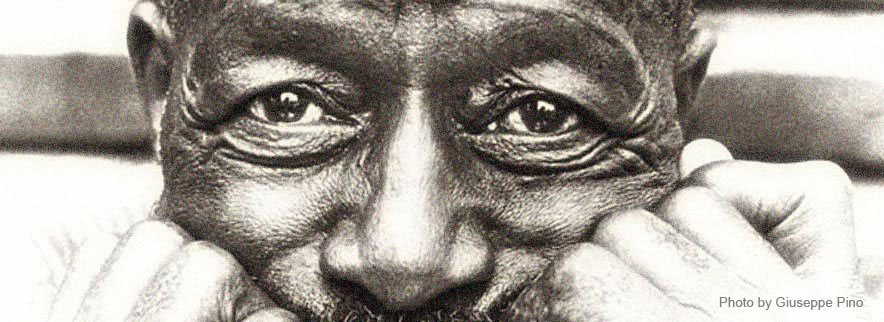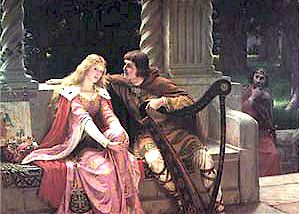In his article “The Blues as a Secular religion”, published in 1970 (1), Rod Gruver, musicologist, draws a comparison between Wagner’s version of Tristan and Isolde, premiered in Munich in 1865 and the blues. At first sight the idea is a weird one, a far-fetched comparison, but still…
For a start, the music drama “Tristan and Isolde” – based on a story that goes back as far as the Greek mythology – as it was composed by Wagner is by many regarded upon as the groundwork for the direction of classical music in the 20th century. Its style broke with existing conventions and impacted the later evolution of classical music. On this general level, a first parallel can be established: both blues and “Tristan and Isolde” have each in their aesthetic, musical space provided for the foundation of later major evolutions. But the analogy goes further than this general observation.
A second, more striking and relevant parallel is that both have put passion between man and woman as central emotion and theme in the spotlight. For the German middle-class population of midst 19th century this operatic masterpiece was unheard off, and the initial reactions were unfavourable, to say only the least. The audience was shocked by the “glorification of sensual pleasure”, and horrified by “the worship of animal passion”. A contemporary composer wrote: ‘’Tristan and Isolde is the most repugnant thing I have ever seen or heard in all my life” (Clara Schumann, quoted in Brauenstein, Joseph (1971). It was a cultural shock.
Can the same not be said of the emergence of the blues which also focused very heavily on the sensual, sexual joy in a social context that was strongly impregnated with the Christian-puritan vision on the man-woman relationship? Was it also not a sort of cultural shock? When W.C. Handy in 1903 heard the music played by a man in a train station in Tutwiler, didn’t he say that it was the ‘weirdest music’ he ever encountered? He was not immediately convinced of the cultural gem that he had the privilege of hearing.
In order to put this statement in perspective, let me take you back in time up to the point of the arrival of the first slaves in the American colonies in the beginning of the 17th century.
When the first slaves were put to work on the plantations they brought along their own religious beliefs and gods. The plantation owners were however not too keen on having their slaves worship their own gods, since this had the potential of keeping alive the desire to return home, and thus to revolt against the brutal structure in which they were integrated (read : imprisoned) . At first, the owners didn’t see too much benefit either of having them reformed to the Christian-protestant belief system. After all, the slaves were imported as commodities and did not rank higher than the mules on their fields. How could there exist a congruence between their view on slaves as dehumanized work force elements and their adherence to the principle of charity and respect for the human person anchored in their religion?
Slowly, their attitude in the matter changed as the missionaries did their job. But the slaves were not presented with the “full monty” of Christianity. It has been observed that the values offered to them stressed the importance of the actual life as a mere preparation for the later life in heaven, after death. The more endurance one showed during the life on earth, the more one ‘earned’ his life in the hereafter. The life on the plantation was only one of pain but it needed to be seen as the anteroom for perpetual happiness up and above. I don’t need to explain that this cultural paradigm was functional for keeping the slaves docile.
The Civil War put an end to a stable society and introduced great uncertainties that were in no way resolved by the efforts of the Reconstruction. The policy of “40 acres and a mule” didn’t work out, and the chains of steal were rapidly replaced by the chains of debt in an economic system based on white supremacy executed through tenancy and sharecropping and legalized through the Jim Crow laws that promoted the canon of ‘separate but equal’.
It is extremely hard, if not impossible, for us, today, to try to even start to imagine and comprehend not only the hardships of those decades after the Civil War, but also the cultural disorientation amongst the African American population. As hard as slavery had been, it had the characteristic that the slave knew exactly what his place was; social life was easy after a few generations. There was birth, pain and death (I’m sarcastic now). The foreman and the plantation owner determined what needed to be done; the slave had no other worries, so to speak.
As ‘freedmen’ the African Americans had to invent a total new social and cultural system. They had to ‘invent’ new values. They were as boats drifting on an ocean, without a compass, looking for a shore.
The black middle class that developed in parallel with the growing urbanisation uttered a clear choice: the assimilation of the cultural system of the white population. Their example for a new society after the Emancipation was the only one which they knew: the white American society with its ethos of the hunt for individual profit and success. The ‘whiter’ the Negro, the better.
Along with this paradigm came the denial of their roots. Their look was a look forward and not one backward to the black, poor social classes which was their cradle. In this way, “the lower class Negro found himself alienated from all classes and all beliefs: he stood all alone in an alien land. The alliance against him was tight and complete. He had no place to go and no one to turn to. He had no country, no home, no ideology and no art to call his own. History had forced upon him the awful realization that, if the black man wanted to have a home of his own in America, he would have to create it himself out of elements of his own culture.” (Gruver, 1970, p. 226).
There was thus a clear split between the black lower social classes and the middle classes, between the outcasts and the ‘would-be insiders’,’the wannabees’’.
The blues arose thus in period of disorientating change from a static, closed and old society to a new dynamic, open and new one. The Black middle class had found a handhold in the ethos of the white society. The lower black classes were left helpless, and could only rely on themselves to reshape their own society, after having been only a dehumanized component in another society. They had no other reference group than the group they once were in a distant past.
Where am I left with my thesis that there is a parallel between ‘Tristan and Isolde’ and the blues? Well, just as Wagner’s masterpiece can be seen as an effort to bring to live again sensuality and passion in the German middle-classes, so can the strong emphasis in the blues on the pleasures of sex be interpreted as a strong signal in the face of the ruling, Christian inspired values which after all saluted the idea the Immaculate Conception. The human sexuality was seen as the enemy of spirituality and the choice was between pleasure now and pain for eternity, between passion and paradise. Christianity had in its evolution alienated the people from their bodies and their sexuality. Also, the male figure plays a dominant role in its traditional male-authority and female-submission value system.
The blues on the contrary put the woman on a pedestal again. ‘Every time she starts to loving, she brings eyesight to the blind; she has the power to heal you, just one word from her lips and the deaf can hear’. As for the man, he is a ‘king’, a ‘King Bee’, full of sexual desire, a ‘natural born lover’. The unity “male-female” as a natural equilibrium is, in contrast to the ruling Christian belief system, put again on top of the agenda. It is true that love is a central theme in most popular music, and also in African American folk, but what makes the blues distinctive is the “provocative and pervasive sexual imagery” “The sexual allusions () have (even) caused them to be labelled quasi-pornographic”. (A. Y. Davis, 1998).
In this newly created cultural system, the blues – as a direct reaction from the poor African American population to their changed social environment, with the emphasis on the human sexuality – was thus clearly a breakaway from the ruling Christian canons. It was the art that the poor black community created for itself. However it was not an ‘art for art’s sake’; as in traditional African music, it had a function in and drew its significance from its particular social context.
It stressed the ‘immediacy of life’, here and now, the nature of the man and human survival, as opposed to the Christian dogma of life hereafter that is earned by a puritan life on earth.
These opposite views between Christianity and blues cannot be seen as the sole, or even the most important, aspects of the relation between both models. This relation is far more complex than this and I won’t go any further on this (2). My main point in this article was to use the parallelism between the opera ‘Tristan and Isolde’ and the blues as an illustration for two essential characteristics of the blues: it laid the foundations for a further evolution of popular music, and it put the man-woman unity with all its sexual aspects again on the foreground, as was done in ‘Tristan and Isolde’, against the ruling norms.
As in other articles I have presented earlier on, I could not resist to put the spotlight on the role that was played by the middle-class African American population in the development of the blues, a role that was typified by their consideration of the blues as ‘deviant’, as ‘denigrating’. But I want to see this also from its positive side: it is my firm conviction that this attitude also implied a lack of interference, which has allowed the blues to grow following its own logic. The blues musician was only accountable to himself and his audience, which were roughly the same. He was free to built his own cultural space, his own ‘mythology’, which could give expression to deeply felt private emotions and could promote catharsis through dance, and could increase feelings of solidarity, boost morale and strengthen consensus (3)
_______________________
(1) Reprinted in “Write me a few of your lines”, S.C. Tracy, ed., 1999
(2) A summary reading on the relation between religion and blues is in “Songs of Zion : Eschaton and Blues in African-American Faith”, Telford Work, Westmont College, 2001
(3) J.M. Spencer, Sacred Music of the Secular City, from blues to rap, 1992



